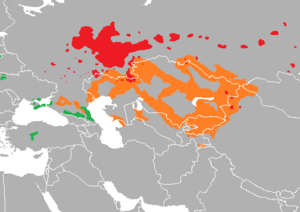Kipchak languages
| Kipchak | |
|---|---|
| Northwestern Turkic | |
| Ethnicity: | Kipchaks |
| Geographic distribution: | — |
| Linguistic classification: |
|
| Subdivisions: |
|
| Glottolog: | kipc1239[1] |
|
Kipchak–Bolgar Kipchak–Cuman Kipchak–Nogai and Kyrgyz–Kipchak | |
The Kipchak languages (also known as the Kypchak, Qypchaq, or Northwestern Turkic languages) are a branch of the Turkic language family spoken by more than 25 million people in an area spanning from Lithuania to China.
Linguistic features
The Kipchak languages share a number of features that have led linguists to classify them together. Some of these features are shared with other Turkic languages; others are unique to the Kipchak family.
Shared features
- Change of Proto-Turkic *d to /j/ (e.g. *hadaq > ajaq "foot")
- Loss of initial *h sound (preserved only in Khalaj. See above example.)
Unique features
- Extensive labial vowel harmony (e.g. olor vs. olar "them")
- Frequent fortition (in the form of assibilation) of initial */j/ (e.g. *jetti > ʒetti "seven")
- Diphthongs from syllable-final */ɡ/ and */b/ (e.g. *taɡ > taw "mountain", *sub > suw "water")
Classification
The Kipchak languages may be broken down into four groups, based on geography and shared features:[1]
- Kipchak–Bulgar (Uralian, Uralo-Caspian): Bashkir and Tatar
- Kipchak–Cuman (Ponto-Caspian): Karachay-Balkar, Kumyk, Karaim, Krymchak. Urum and Crimean Tatar appear to have a Kipchak–Cuman base, but have been heavily influenced by Oghuz languages.
- Kipchak–Nogai (Aralo-Caspian): Nogai, Karakalpak and Kazakh.
- Kyrgyz–Kipchak: Kyrgyz and Southern Altai.
The language of the Mamluks in Egypt appears to have been a Kipchak language, probably one belonging to the Kipchak–Cuman group.
See also
References
- 1 2 Hammarström, Harald; Forkel, Robert; Haspelmath, Martin; Bank, Sebastian, eds. (2016). "Kipchak". Glottolog 2.7. Jena: Max Planck Institute for the Science of Human History.
Bibliography
- Johanson, Lars; Csató, Éva Ágnes (1998). The Turkic Languages. London: Routledge. ISBN 0-415-08200-5.
- Menges, Karl H. (1995). The Turkic Languages and Peoples (2nd ed.). Wiesbaden: Harrassowitz. ISBN 3-447-03533-1.
This article is issued from Wikipedia - version of the 10/11/2016. The text is available under the Creative Commons Attribution/Share Alike but additional terms may apply for the media files.
